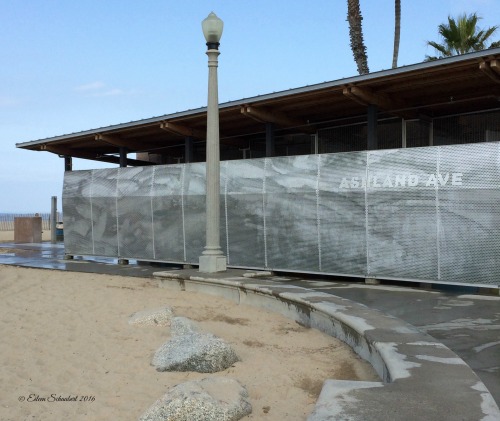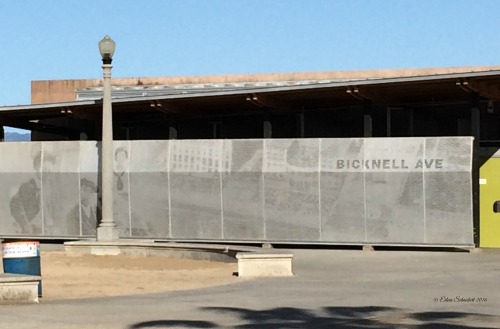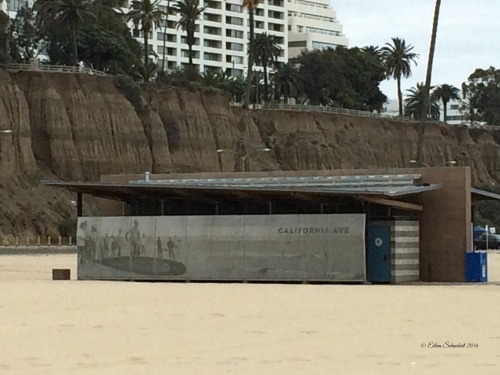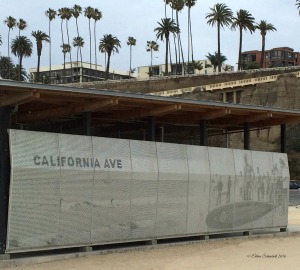Santa Monica Beach Stories
Many people over the centuries have shaped the seaside town of Santa Monica – who are they?
Santa Monica Beach Stories are found in unassuming places. But places that we all visit at some point – the public restrooms along the beach path. A public art project that adds comfort and interest to the beach experience.
Each photo has an accompanying plaque with a little info explaining the photo and its relevance. I was hoping to have additional background information but at the moment the City’s website is undergoing an update. So – for this post I’m going to simply include the text from each plaque.
What I find amazing is the technique used to recreate these large black and white historical photos. The images are dots punched out of sheet metal over a darker metal mesh wall so the images are subtle, almost hard to see. The technique is called Halftone and the effect is created by varying the dot size and spacing between the dots. Remember old-style newsprint photos?
Grunion Runs – Ashland Ave
I had no idea that this is an ongoing occurrence and a Grunion Run is predicted for tonight through Saturday night. I’ll be hitting the beach tonight in hopes of seeing this amazing spectacle of nature!
The Grunion is a small fish that has swarmed sandy beaches from Point Conception to Baja California for centuries, creating a spectacle unique to the Southern California area. At night Grunions “run” up on shore during annual hight tide in order to dig holes in the sand to place their fertilized eggs and then return to the ocean.
The Tonga harvested Grunion during these onshore spawning periods and Juan Cabrillo noted the presence of Grunions at Santa Monica Beach in his ship log in 1542. Grunion are one of the few fish that legally can be caught by using just hands.
Native Story – Ocean Park Blvd
Without the park name and this photo, the presence of the Tongva in this place would be lost to most of us. Tongva Park bridges the space from Santa Monica City Hall and the Santa Monica Pier. Coming from Minneapolis, I am used to having a more noticeable Native American presence than I have found here in Los Angeles.
The Tongva or Gabrieleno Tribe settled in the Santa Monica-Malibu area thousands of years ago. The Tongva were admired by Spanish Explorers for their large seaworthy plank canoes called TE’AAT that could hold up to 12 people. Driftwood planks were sewn together and their edges sealed with tar or pine pitch. Early populations were estimated at 5,500 and today approximately 1,500 people make up the growing Tongva tribe. The Tongva have a special relationship with the sea that is recounted in the legend of Torovim:
A Tongva Chieftain was being pursued by an enemy tribe somewhere in Topanga – “where the mountains meet the sea”. He came to a cliff. Rather than submit to his captors, he dove into the sea. As he fell, he changed into the Dolphin or Torovim – “our brother of the ocean”. He now swims around the world, staying ever vigilant and alert to ensure the safety of our people. It is his duty as caretaker of the ocean. And, when Torovim is no more, our people will also cease to be.
The Pleasure Piers – Hollister St
During the first decades of the twentieth century, numerous pleasure piers dotted the beach. The White Star Pier was built in 1905 at the foot of Hollister Street.
It was renamed the Bristol Pier in 1909 and redesigned in an L-Shape. In 1919 a portion of the pier was removed and the remainder was widened.
Actor Nat Goodwin took over the site and opened Nat Goodwin’s Cafe. At the time the Pier was renamed the Crystal Pier and remained until it was demolished in 1949.
The Santa Monica Pier still delights. At the terminus of Route 66, it has an amusement park, an aquarium, restaurants, fishing piers and street entertainers. Summertime brings concerts and movie nights. I’ve had a love for amusement parks ever since my Dad took me on my first roller coaster ride when I was 4 at the beach in Santa Cruz. As the lights flicker on at dusk, I remember all the joyous days my family spent riding coasters at the beach.
The Inkwell – Bicknell Ave
A place of celebration and pain. Between Bay and Bicknell Streets there is a beach known by some as the “Ink Well”. This small stretch of shoreline was an important gathering place for African Americans long after racial restrictions on public beaches were abandoned in 1929. Located in close proximity to nearby African American neighborhoods and the Phillips Chapel CME Church African-American groups from Venice, Los Angeles and Santa Monica came here to enjoy the sun and surf because here they encountered less racially-motivated harassment than at other southland beaches.
What was known as the Ink Well is my home stretch of beach – it is at the end of my street and where I like to spend my mornings. I knew of its history from the marker and annual events sponsored by the Black Surfers Association.
The Palisades – Arizona Ave
The Palisades are a natural red sandstone cliff formation that defines the Northern edge of Santa Monica Beach and separates the shore from residential neighborhoods above. Access to the beach from the Palisades was made possible by the construction in 1875 of the “99 Steps” At the base of Arizona Avenue another access point was provided by the Thompson Scenic Railroad. A 509-foot long undulating track that used gravity to transport guests to and from the historic Arcadia Hotel. The California Incline built in the 1920s continues to provide vehicular and pedestrian access between the beach and the city above.
The Palisades can be seen in the photo below. They are beautiful to look at and a number of pedestrian bridges spanning the Pacific Coast Highway allow for a closer view as you climb stairs to the parkland above.
Lifeguarding – California Ave
Ocean swimming was not a popular recreational activity in the early 1900s and as a result the first lifeguards worked in the plunges (indoor salt water pools) preferred by vacationers.
As ocean swimming grew in popularity, avid surfers George Freeth and George Washington Watkins organized a volunteer life-saving corps. Later Freeth would revolutionize modern lifeguarding techniques.
Volunteer lifeguards continued to patrol the beach until the early 1930s when the city funded the first professional lifeguarding service.
Even during the low season, lifeguards have a presence on key sections of the beach. The iconic blue stations were made famous by the TV show Baywatch – filmed just across the city limit on the beach in Pacific Palisades.
Beach Volleyball – Montana Ave
Beach volleyball is still very popular with dozens of courts set up in Santa Monica. Moving south into El Segundo, Redondo Beach and Manhattan Beach the game fills the beaches.
Beach volleyball was brought to Santa Monica by Hawaiians such as Duke Kahanamoka who first played the game at the Waikiki Outrigger Beach & Canoe Club.
When Duke came to California, he was employed by the Santa Monica Beach Club where he helped popularize the game in the early 1920s.
The Sorrento Bar and grill in Santa Monica became the unofficial headquarters of California beach volleyball. Nothing was more California than a beach volleyball tournament at Sorrento Beach.
See – isn’t amazing what you can find out at the local restrooms? Thanks for joining me on my beach ride today!












wow!!! they look so artistic and different ! your pictures are very nice !
LikeLike
Thanks. I’ve actually learned a lot from this project.
LikeLike
Beautiful pictures
LikeLike
Thanks for stopping by!
LikeLiked by 1 person
That’s certainly true Eileen, you can learn a lot from restrooms 🙂 I did enjoy your ride and wonder if you ride everyday and if so how far do you go? I’m a casual rider but I do enjoy going on rail trails and shared pathways where the gradients are quite gentle and i can ride for hours taking in the sights along the way. I live in a hilly place so I have to be able to go up and down hills which is good for my fitness.
LikeLike
I don’t ride everyday here in Santa Monica – so many things are walkable that I skip the bike. But, I have taken the 30 Days of Biking pledge which is every April so I will be riding every day that month. We are moving again soon so I will be riding most days this summer – sometimes casual rides and other times longer rides.
LikeLiked by 1 person
That pledge sounds interesting. Enjoy the arrival of warmer weather as we descend slowly into autumn down here.
LikeLike
These sound like fun beaches to visit, lots going on with some super shots too!
LikeLike
Not quite as sandy as your home these days but yes, there is always lots of action going on at the beach.
LikeLike
Eileen – did you do any research into the Sorrento Beach Grill? I’m interested in the year it was built, who all owned it and what names it had before it became the repository for the beach volleyball “Wall of Fame”. If you have any information (or not) please contact me at lmorris@pobox.com. Thanks.
LikeLike
Sorry Linda, I didn’t do any further research. Maybe on our next trip to LA!
LikeLike